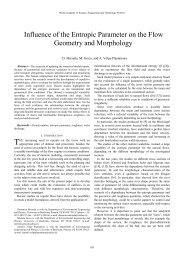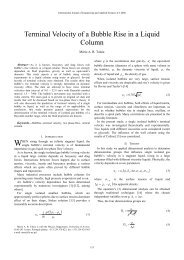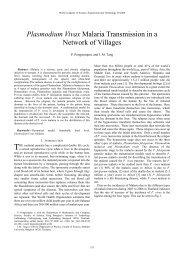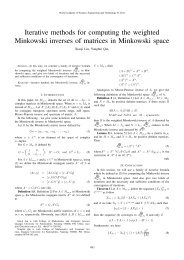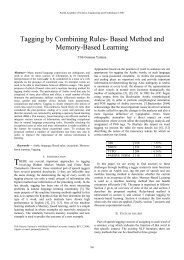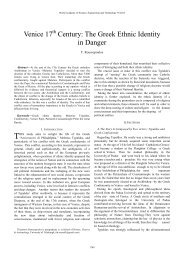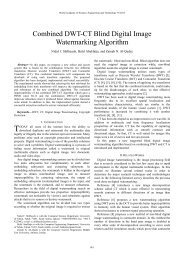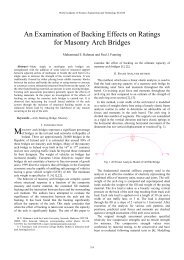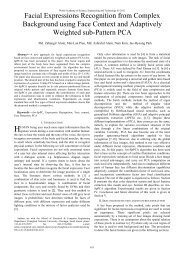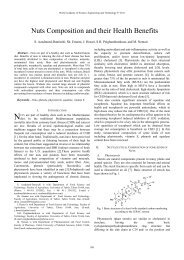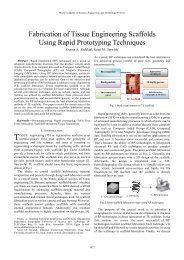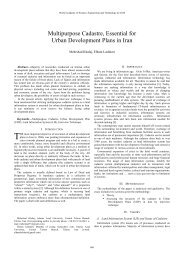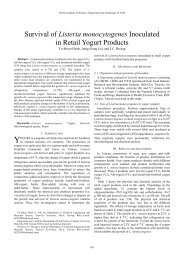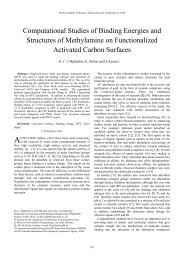Survey on the Possibility of Post -Earthquake Quick Inspection of ...
Survey on the Possibility of Post -Earthquake Quick Inspection of ...
Survey on the Possibility of Post -Earthquake Quick Inspection of ...
Create successful ePaper yourself
Turn your PDF publications into a flip-book with our unique Google optimized e-Paper software.
Abstract—In recent years, <strong>the</strong> number <strong>of</strong> natural disasters in <strong>the</strong><br />
world has occurred frequently. After a str<strong>on</strong>g earthquake occurs,<br />
multiple disasters due to tsunami, str<strong>on</strong>g aftershocks or heavy snow<br />
can possible to occur. To prevent a sec<strong>on</strong>dary disaster and to save a life,<br />
<strong>the</strong> quick inspecti<strong>on</strong> <strong>of</strong> <strong>the</strong> damaged building is necessary. This paper<br />
investigated <strong>on</strong> a possibility <strong>of</strong> post earthquake quick inspecti<strong>on</strong> <strong>of</strong><br />
damaged building by ordinary people which used <strong>the</strong> European<br />
Macro- Seismic Scale 1998 (EMS-98).<br />
Keywords—<strong>Quick</strong> Assessment, EMS-98, Ordinary People,<br />
<strong>Post</strong>-<strong>Earthquake</strong><br />
R<br />
I. INTRODUCTION<br />
ECENTLY, various natural disasters have frequently<br />
occurred around Asia because <strong>of</strong> a change in envir<strong>on</strong>ment,<br />
an ec<strong>on</strong>omical rapid growth, etc. After a str<strong>on</strong>g earthquake<br />
occurs, multiple disasters due to str<strong>on</strong>g aftershocks, heavy rain,<br />
landslide or heavy snow can possible to occur [1].<br />
The damaged building can cause fur<strong>the</strong>r injuries and death to<br />
residents. To prevent a sec<strong>on</strong>dary disaster, to save a life, to<br />
restore a mental balance, and to protect properties from<br />
aftershocks, a quick inspecti<strong>on</strong> <strong>of</strong> <strong>the</strong> damaged building is<br />
needed. However, for evaluating structural safety a lot <strong>of</strong><br />
specialists are needed, it takes time and a lot <strong>of</strong> m<strong>on</strong>ey. But,<br />
foreign aid and rescue team <strong>on</strong>ly pay attenti<strong>on</strong> to <strong>the</strong> famous<br />
earthquake and specialists are insufficient in developing<br />
country [2], [3].<br />
On <strong>the</strong> afterno<strong>on</strong> <strong>of</strong> May 12, 2008, an earthquake measuring<br />
7.9 <strong>on</strong> <strong>the</strong> Richter scale hit Sichuan Province, a mountainous<br />
regi<strong>on</strong> in Western China. The earthquake killed more than<br />
69,107 and 373,577 were injured, with ano<strong>the</strong>r 18,230 people<br />
are still missing. Over 15 milli<strong>on</strong> people live in <strong>the</strong> affected<br />
area, including almost 4 milli<strong>on</strong> in <strong>the</strong> city <strong>of</strong> Chengdu, homes,<br />
schools and apartments in Sichuan Province were poorly<br />
designed, with a severe shortage <strong>of</strong> <strong>the</strong> steel reinforcement.<br />
As <strong>of</strong> May 21th, 162 aftershocks had been m<strong>on</strong>itored in<br />
Bureau.<br />
Douangmala Kounsana, Lecturer, Dr. Eng. Department <strong>of</strong> Civil Engineering,<br />
Nati<strong>on</strong>al University <strong>of</strong> Laos. Lao-Thai Friendship Rd,Sokpaluang Campus,<br />
P.O.Box:3166. Vientiane Capital City, Lao P.D.R (ph<strong>on</strong>e:+ 856-21-351926;<br />
fax: 856-21-314382;e-mail: douangmala2004@yahoo.com)<br />
Toru Takahashi, Pr<strong>of</strong>essor, Dr. Eng. Department <strong>of</strong> Architecture, Chiba<br />
University. Dr. Eng. JAPAN. 1-33 Yayoicho, Inage-ku, Inage-ku, Chiba<br />
263-8522, JAPAN (ph<strong>on</strong>e: +81-43-290-3145, Fax:+81-43-290-3146;e-mail:<br />
takahashi.toru@faculty.chiba-u.jp).<br />
World Academy <strong>of</strong> Science, Engineering and Technology 70 2012<br />
<str<strong>on</strong>g>Survey</str<strong>on</strong>g> <strong>on</strong> <strong>the</strong> <strong>Possibility</strong> <strong>of</strong> <strong>Post</strong> -<strong>Earthquake</strong><br />
<strong>Quick</strong> Inspecti<strong>on</strong> <strong>of</strong> Damaged Building by<br />
Ordinary People using <strong>the</strong> European<br />
Macro-Seismic Scale 1998 (EMS-98)<br />
Douangmala Kousnana, Toru Takahashi<br />
1010<br />
Am<strong>on</strong>g <strong>the</strong>m, 26 aftershocks measured higher than 5.0 <strong>on</strong><br />
<strong>the</strong> Richter scale, more than 490,000 buildings were collapsed<br />
and a lot <strong>of</strong> buildings were cracked and needed to reinforce<br />
immediately. But foreign rescue teams were not allowed into<br />
Sichuan until May 16. However, <strong>the</strong> specialists from T<strong>on</strong>gchi<br />
University had d<strong>on</strong>e <strong>the</strong> rapid evaluati<strong>on</strong> safety in <strong>the</strong> damaged<br />
area.<br />
In additi<strong>on</strong>, according to our survey in Dujiangyang City,<br />
Chengdu province for 7 days, <strong>the</strong>re were str<strong>on</strong>g evidences that<br />
after <strong>the</strong> terrible event calm down, residents returned to <strong>the</strong>ir<br />
house for taking properties, <strong>the</strong>y went back inside and living in<br />
<strong>the</strong> damaged building which had been unchecked <strong>the</strong> safety.<br />
Those acti<strong>on</strong>s can bring a tragedy to people’s life as ano<strong>the</strong>r<br />
disaster [4].<br />
The rapid safety evaluati<strong>on</strong> and <strong>the</strong> quick reinforcement <strong>of</strong><br />
buildings help prevent loss <strong>of</strong> life and property from <strong>the</strong><br />
sec<strong>on</strong>dary disaster. For classifying <strong>the</strong> visual damage <strong>of</strong><br />
buildings <strong>the</strong> European Macro-seismic Scale 1998 (EMS-98)<br />
were used [5], [6], [7], [8], [9], [10].<br />
Based <strong>on</strong> <strong>the</strong> different circumstances and politics that exists<br />
in developing countries, this paper provides a new idea <strong>on</strong> a<br />
quick assessment <strong>of</strong> damaged building for ordinary people by<br />
using European Macro-seismic Scale 1998 (EMS-98), we have<br />
d<strong>on</strong>e a survey to measure <strong>the</strong> possibility <strong>on</strong> quick assessment <strong>of</strong><br />
damaged building by ordinary people.<br />
II. CONTENTS AND METHOD OF SURVEY<br />
For evaluating <strong>the</strong> level <strong>of</strong> damage from earthquake <strong>on</strong><br />
building by ordinary people, <strong>the</strong> European Macro-seismic<br />
Scale 1998 (EMS-98) and 52 photographs <strong>of</strong> damage building<br />
which taken from Sumatra earthquake and several Japan<br />
earthquakes were used, and 44 people from 9 countries were<br />
checked <strong>the</strong> damage <strong>of</strong> building from <strong>the</strong> photographs. The<br />
participants were checked damage <strong>on</strong> building and determined<br />
<strong>the</strong> damage level by comparing <strong>the</strong> damage which seen from<br />
<strong>the</strong> photographs and illustrati<strong>on</strong> from <strong>the</strong> EMS-98.<br />
A. European Macro-seismic Scale 1998 (EMS-98)<br />
The European Macro-seismic Scale 1998 is a basic scale for<br />
assigning seismic intensity in European countries. Most<br />
recently updated in 1998, <strong>the</strong> scale is referred to as EMS-98.<br />
The EMS-98 is <strong>the</strong> first intensity scale designed to encourage<br />
co-operati<strong>on</strong> between engineers and seismologists, ra<strong>the</strong>r than
eing for use by seismologists al<strong>on</strong>e, it comes with a detailed<br />
manual, which includes guidelines, illustrati<strong>on</strong>s, and<br />
applicati<strong>on</strong> examples. The term macro-seismic intensity is used<br />
entirely in <strong>the</strong> meaning <strong>of</strong> a classificati<strong>on</strong> <strong>of</strong> <strong>the</strong> severity <strong>of</strong><br />
ground shaking <strong>on</strong> <strong>the</strong> basis <strong>of</strong> observed effects in a limited<br />
area.<br />
B. Type <strong>of</strong> Photographs<br />
52 photographs <strong>of</strong> damage building from <strong>the</strong> Sumatra<br />
earthquake and <strong>the</strong> Japan earthquake were used in this survey.<br />
In that, 27 photographs are mas<strong>on</strong>ry and 25 photographs are<br />
reinforced c<strong>on</strong>crete buildings, respectively. Because a limit <strong>of</strong><br />
number <strong>of</strong> photos that used in this survey, some <strong>of</strong> unclear<br />
damage level photos were used.<br />
In additi<strong>on</strong>, for improving <strong>the</strong> method, some photos <strong>of</strong> <strong>the</strong><br />
same building which were taken in different distance and<br />
directi<strong>on</strong> are used. Table II shows <strong>the</strong> number and damage level<br />
<strong>of</strong> photographs. The Photographs which used in this survey are<br />
shown in Fig. 1 to2 respectively.<br />
Damage Level<br />
TABLE I<br />
NUMBER OF PHOTOGRAPH AND DAMAGE LEVEL<br />
Structure Type<br />
Mas<strong>on</strong>ry RC<br />
Level 1 7 1<br />
Level 2 5 7<br />
Level 3 3 5(4*)<br />
Level 4 6 4<br />
Level 5 6 8<br />
Total 27 25<br />
(*) same building photos which were taken different approach<br />
III. SURVEY AND QUESTIONAIRE CONTENTS<br />
A questi<strong>on</strong>naire survey was c<strong>on</strong>ducted for 3 days from 12 th<br />
April to 14 th April 2007. 44 people with 9 nati<strong>on</strong>alities were<br />
surveyed. In that, 19 are male, 25 are female, 35 are foreign<br />
students and 9 are Japanese. They were divided into 2 groups,<br />
group 1 was <strong>the</strong> group that has no knowledge about structure<br />
which has 34 people and <strong>the</strong> o<strong>the</strong>r group have, which have 10<br />
people in <strong>the</strong> group.<br />
They were 2 parts in <strong>the</strong> questi<strong>on</strong>naire form, first part was <strong>the</strong><br />
questi<strong>on</strong>naire about general informati<strong>on</strong> and sec<strong>on</strong>d part was a<br />
table for writing an answer after check <strong>the</strong> safety <strong>on</strong> buildings<br />
from <strong>the</strong> damage photos. The questi<strong>on</strong>naire c<strong>on</strong>tents are shown<br />
in Table II.<br />
World Academy <strong>of</strong> Science, Engineering and Technology 70 2012<br />
1011<br />
TABLE II<br />
QUESTIONNAIRE CONTENT<br />
Item Questi<strong>on</strong>naire<br />
1 What is your country name and sex?<br />
2 What is your major?<br />
3 Are you undergraduate student? Researcher? Master?<br />
Doctoral? Civilian? O<strong>the</strong>r?<br />
4 Please select your age group<br />
5 Does earthquake occur <strong>of</strong>ten in your country or not?<br />
6 How <strong>of</strong>ten do you have experience earthquakes?<br />
7 Please select earthquake level have you ever experienced<br />
8 How much do you pay for buying house in percentage?<br />
9 How much do you pay for reinforcing your house in<br />
percentage?<br />
10 Does <strong>the</strong> check easy or difficult?<br />
11 What do you think about <strong>the</strong> structural safety which check by<br />
seeing <strong>the</strong> damage building photographs and checking <strong>the</strong><br />
safety by your self<br />
12 If an earthquake occurs in <strong>the</strong> future can you check <strong>the</strong> safety<br />
<strong>of</strong> your house by using <strong>the</strong> checking?<br />
13 How’s c<strong>on</strong>fidence <strong>on</strong> <strong>the</strong> structural safety checking in this<br />
time?<br />
14 If you have any comments, suggesti<strong>on</strong>s about this survey,<br />
please d<strong>on</strong>’t hesitate.<br />
IV. SURVEY AND ANALYSIS RESULT<br />
A. General Informati<strong>on</strong> <str<strong>on</strong>g>Survey</str<strong>on</strong>g> Result<br />
In <strong>the</strong> first part <strong>of</strong> survey, <strong>the</strong> questi<strong>on</strong>naire c<strong>on</strong>tent is ask<br />
about <strong>the</strong> participant’s pers<strong>on</strong>al informati<strong>on</strong> such as gender, age,<br />
major, earthquake experiences, etc. The survey results are as<br />
follows.<br />
By Country, China represents <strong>the</strong> maximum number <strong>of</strong> 22<br />
people, followed by Japan (9), Koreans (4), Ind<strong>on</strong>esia (3), Laos<br />
(1), Papuanewguinea (1), Malaysia (1), Thai (1), Taiwan (1)<br />
and Vietnam (1).<br />
By Major, 23% <strong>of</strong> participants are bel<strong>on</strong>g to Architecture and<br />
engineering, followed by Medicine (11%), Ec<strong>on</strong>omic (11%),<br />
Science (9%), Literature and Educati<strong>on</strong> (7%), Law (5%),<br />
Gardening, and O<strong>the</strong>r (2%).<br />
By school year, Doctoral Students were <strong>the</strong> biggest group<br />
with 30%, followed by Master (29%), Undergraduate (25%),<br />
Public (11%) and o<strong>the</strong>r (5%).<br />
By age, 31% <strong>of</strong> participants were in <strong>the</strong> age range <strong>of</strong> 20-24<br />
and 25-29 years old, followed by 30-34 (30%), 55-59 (5%),<br />
50-54 (2%), and 40-44 (2%).<br />
To <strong>the</strong> questi<strong>on</strong> No.5: "Does earthquake occur <strong>of</strong>ten in your<br />
country or not "66% replied "No" and 34% replied "Yes".
To <strong>the</strong> questi<strong>on</strong> No.6: "How <strong>of</strong>ten do you have experience <strong>on</strong><br />
earthquakes?" 63% answered "sometimes", 18% "Rarely", 14%<br />
"Frequency", and 5% "Never".<br />
To <strong>the</strong> questi<strong>on</strong> No.7: "Please select earthquake level have<br />
you ever experienced", 61% selected "few scary level", 34%"<br />
feel shaking extent level", and 5% " feel building shaking<br />
level".<br />
To <strong>the</strong> questi<strong>on</strong> No.9: "How much do you pay for reinforcing<br />
house by percentage?"40% answered 10% and 21% answered<br />
5% respectively. Fig.3 (a) to (f) shows general informati<strong>on</strong><br />
survey result.<br />
World Academy <strong>of</strong> Science, Engineering and Technology 70 2012<br />
1012<br />
Fig. 3 General informati<strong>on</strong> result (a)-(f)<br />
B. Structural Assessment Result<br />
To compare and check <strong>the</strong> answer from participants <strong>the</strong><br />
authors asked Pr<strong>of</strong>. Toru Takahashi and Assoc. Pr<strong>of</strong> Koichi<br />
Ohami from structural laboratory, Chiba University to classify<br />
damage level <strong>of</strong> buildings, <strong>the</strong> answer assumed to correct<br />
answer. The authors compared <strong>the</strong> correct answer with 2 groups<br />
in three ways. The structural assessment results are as follows:<br />
1. Mode Value<br />
The authors compared <strong>the</strong> mode value <strong>of</strong> group 1 and group<br />
2, <strong>the</strong> results are as follows.<br />
First, <strong>the</strong> result <strong>of</strong> ordinary people group (group1) was<br />
different 12 in 27 photographs, in that 8 were similar, 15 photos
were same answer with <strong>the</strong> correct answer, and 3 photos were<br />
not match at all for mas<strong>on</strong>ry structure. However, 11 were<br />
different in 25 photos for reinforced c<strong>on</strong>crete structure, in that<br />
8 photos were similar answer, 14 photos were same answer<br />
with <strong>the</strong> correct answer, and <strong>on</strong>ly 2 photos which not match at<br />
all. The ratio <strong>of</strong> same answer was 55.6% and 56.0%,<br />
respectively.<br />
Sec<strong>on</strong>d, <strong>the</strong> result <strong>of</strong> architecture group (group2) was<br />
different 9 photographs, in that 7 photos were similar answer,<br />
18 were same answer with <strong>the</strong> correct answer, and 3 photos<br />
weren’t match at all for mas<strong>on</strong>ry structure. For RC structure, 10<br />
photos were different, in that 7 photos were similar answer, 15<br />
photos were same answer with <strong>the</strong> correct answer, and 3 photos<br />
weren’t match at all. The ratio <strong>of</strong> same answer was 66.7% and<br />
60%, respectively. The mode value result shows in Table III.<br />
Answer<br />
Same<br />
Answer<br />
Similar<br />
Answer<br />
Not Match<br />
at All<br />
TABLE III<br />
MODE VALUE OF CORRECT ANSWER<br />
Mas<strong>on</strong>ry RC<br />
Group1 Group2 Group1 Group2<br />
15 18 14 15<br />
9 7 8 7<br />
3 2 3 3<br />
Total 27 27 25 25<br />
Unit: Photograph<br />
2. Accuracy Rate<br />
The authors compared accuracy rate survey results <strong>of</strong> 2<br />
groups. The results are as follows.<br />
First, <strong>the</strong> accuracy rate <strong>of</strong> group 1 is lower than group 2 for<br />
both structures, <strong>the</strong> difference <strong>of</strong> two groups was 8% for<br />
mas<strong>on</strong>ry and 5.8% for RC structure. The value is shown in<br />
Table IV.<br />
TABLE IV<br />
ACCURACY RATE BY STRUCTURE TYPE<br />
Structure Group1 Group 2<br />
Mas<strong>on</strong>ry 37.7% 45.7 %<br />
RC 37.8 % 43.6 %<br />
Sec<strong>on</strong>d, <strong>the</strong> difference <strong>of</strong> <strong>the</strong> answer by countries isn’t big,<br />
except <strong>the</strong> answer from Taipei and Lao student, 60% for RC<br />
structure, 33.3% and 59.3 for mas<strong>on</strong>ry structure respectively.<br />
The accuracy rate value is indicated within 30% to 60%. The<br />
result by country <strong>of</strong> ordinary people group and architect group<br />
is shown in Table V and Table VI respectively.<br />
World Academy <strong>of</strong> Science, Engineering and Technology 70 2012<br />
1013<br />
TABLE V<br />
ACCURACY RATE BY COUNTRY OF ORDINARY PEOPLE<br />
Country<br />
China<br />
Japan<br />
Papuguinia<br />
Korea<br />
Ind<strong>on</strong>esia<br />
Taipei<br />
Thai<br />
Malaysia<br />
Vietnam<br />
Mas<strong>on</strong>ry<br />
34.5<br />
35.8<br />
51.8<br />
47.2<br />
42.0<br />
33.3<br />
44.4<br />
44.4<br />
29.7<br />
Structure Type<br />
Reinforced C<strong>on</strong>crete<br />
38.5<br />
41.3<br />
28.0<br />
37.0<br />
44.0<br />
60.0<br />
32.0<br />
44.0<br />
32.0<br />
TABLE VI<br />
ACCURACY RATE BY COUNTRY OF ARCHITECT PEOPLE<br />
Country<br />
China<br />
Japan<br />
Lao<br />
Mas<strong>on</strong>ry<br />
45.7<br />
43.0<br />
59.3<br />
Structure Type<br />
Reinforced C<strong>on</strong>crete<br />
41.3<br />
49.3<br />
60.0<br />
3. Average and Standard Deviati<strong>on</strong> <strong>of</strong> Damage Level<br />
The average and standard deviati<strong>on</strong> <strong>of</strong> damaged level are as<br />
follows.<br />
As for <strong>the</strong> average <strong>of</strong> mas<strong>on</strong>ry structure, <strong>the</strong> ordinary people<br />
group’s result was slightly higher than <strong>the</strong> architect group and<br />
show opposite result for reinforced c<strong>on</strong>crete structure. The<br />
mas<strong>on</strong>ry structure <strong>of</strong> <strong>the</strong> difference between 2 groups is a little<br />
higher than RC structure, but <strong>the</strong> difference was very small. On<br />
<strong>the</strong> o<strong>the</strong>r hand, <strong>the</strong> correlati<strong>on</strong> coefficient <strong>of</strong> 2 groups shows a<br />
str<strong>on</strong>g correlati<strong>on</strong>.<br />
As for <strong>the</strong> standard deviati<strong>on</strong>, <strong>the</strong> value shows from 0.5 to 1,<br />
<strong>the</strong> variati<strong>on</strong> <strong>of</strong> mas<strong>on</strong>ry structure is higher than RC structure<br />
and isn’t much difference between 2 groups. Meanwhile, <strong>the</strong>re<br />
is no correlati<strong>on</strong> in <strong>the</strong>ir standard deviati<strong>on</strong> between 2 groups.<br />
The change is also small and <strong>the</strong> reliability is obtained to <strong>the</strong><br />
same degree. The Average and standard deviati<strong>on</strong> <strong>of</strong> accuracy<br />
rate results are shows in Fig.4 (a) to (b) and Fig.5 (a) to (b)<br />
respectively.
Fig. 4 Average <strong>of</strong> accuracy rate (a)-(b)<br />
World Academy <strong>of</strong> Science, Engineering and Technology 70 2012<br />
1014<br />
Fig. 5 Standard deviati<strong>on</strong> <strong>of</strong> accuracy rate (a)-(b)<br />
V. CONCLUSION<br />
(1) The possibility <strong>of</strong> <strong>the</strong> quick assessment <strong>of</strong> damaged<br />
building for ordinary people has been investigated. It<br />
was found that:<br />
(2) The ratio <strong>of</strong> mode value <strong>of</strong> <strong>the</strong> same answer result <strong>of</strong><br />
Architecture group is a bigger than Ordinary people<br />
group. The difference <strong>of</strong> 2 groups about 11.1% for<br />
mas<strong>on</strong>ry structure and 4% for RC structure,<br />
respectively.<br />
(3) The average accuracy rate <strong>of</strong> mas<strong>on</strong>ry structure shows<br />
38% for ordinary people group and 46% for<br />
architecture, group respectively. In additi<strong>on</strong>, <strong>the</strong><br />
average accuracy rate <strong>of</strong> reinforced structure shows<br />
38% for group1 and 44% for group2, respectively.<br />
(4) The difference <strong>of</strong> average accuracy rate between<br />
ordinary people group and architecture group was not<br />
large. It was 8% for mas<strong>on</strong>ry, and 6% for reinforced<br />
c<strong>on</strong>crete structure.<br />
(5) The difference <strong>of</strong> average accuracy rate by countries<br />
wasn’t that big. The value indicated within 30% to<br />
60%, except <strong>the</strong> answer from Taipei and Lao student,<br />
60% for RC structure and 60% for both structures.<br />
(6) The difference between male and female isn’t large<br />
about 3%.It is clearly that using <strong>the</strong> clear photographs<br />
will lead <strong>the</strong>m to a correct decisi<strong>on</strong>.<br />
VI. DIFFERENCE FACTORS<br />
Difference factors are as follow:<br />
First, <strong>the</strong> EMS-98 which used in <strong>the</strong> survey doesn’t cover<br />
inclined building. Therefore, <strong>the</strong>y could not select <strong>the</strong> correct<br />
answer, Fig.6 (a) and (c).<br />
Sec<strong>on</strong>d, it is very difficult for ordinary people who d<strong>on</strong>’t<br />
have knowledge in a field <strong>of</strong> structure to determine <strong>the</strong><br />
damaged level correctly when a top part <strong>of</strong> structure isn’t<br />
collapse but <strong>the</strong> first floor collapsed, Fig.6 (b).
Third, <strong>the</strong> building partially destroyed but <strong>the</strong> remaining part<br />
was perfect state, <strong>the</strong>refore <strong>the</strong>y could not determine <strong>the</strong> level<br />
correctly Fig.6 (d).<br />
Fourth, <strong>the</strong>y could not determine correctly <strong>the</strong> kind <strong>of</strong><br />
building which <strong>the</strong> main part <strong>of</strong> building collapsed and lose<br />
<strong>on</strong>e’s structural support, especially ordinary people. (Fig.6)<br />
Firth, <strong>the</strong>y could not determine correctly <strong>the</strong> buildings which<br />
suffer great damage but building frame still remaining.<br />
Sixth, unclear and difficult to see <strong>the</strong> damage photographs<br />
were used, etc.<br />
Seventh, Different structure types <strong>of</strong> photographs (2 photos)<br />
were mixed in <strong>the</strong> photographs.<br />
Eighth, <strong>the</strong> photograph which takes with different angles and<br />
distances can give a different decisi<strong>on</strong> even it was <strong>the</strong> same<br />
building photo, and it was c<strong>on</strong>firmed in this survey.<br />
In this research, <strong>the</strong> authors provided a new way <strong>of</strong> quick<br />
assessment <strong>of</strong> damaged building for ordinary people by using<br />
<strong>the</strong> EMS-98. The accuracy rate <strong>of</strong> structural check by<br />
individual was about 30% to 50%, but <strong>the</strong> mode value was<br />
shown in high value about 78%. The importance and necessity<br />
<strong>of</strong> a quick safety check was rec<strong>on</strong>firmed in our survey in<br />
Dujiangyang City <strong>on</strong> 2008, but <strong>the</strong> actual situati<strong>on</strong> in each<br />
country is not supported. The most important thing about this<br />
study is providing <strong>the</strong> way for ordinary people to help <strong>the</strong>m<br />
check <strong>the</strong> safety by <strong>the</strong>mselves when needed. However, <strong>the</strong><br />
checking need to improve and to use this checking <strong>the</strong> proposal<br />
educati<strong>on</strong> and training several times per year is needed. To<br />
increase <strong>the</strong> likelihood <strong>of</strong> <strong>the</strong> result in <strong>the</strong> future, few<br />
photographs <strong>of</strong> <strong>the</strong> same building which take with different<br />
angles and distances are needed.<br />
The difference between ordinary people group and<br />
architecture group is determining <strong>the</strong> loss <strong>of</strong> structural support<br />
<strong>of</strong> damaged building and classifying an inclined building.<br />
If we used mode value or check <strong>the</strong> structural safety by large<br />
number, give training and educati<strong>on</strong>, we can expect it in <strong>the</strong><br />
near future.<br />
This study is a first step for checking possibilities, and <strong>the</strong><br />
possibility was c<strong>on</strong>firmed and it is highly likely that it’s<br />
possible for ordinary people to check <strong>the</strong> safety. Fig.6 (a) to (d)<br />
shows an example <strong>of</strong> damage classificati<strong>on</strong> by ordinary people<br />
group and architecture group.<br />
World Academy <strong>of</strong> Science, Engineering and Technology 70 2012<br />
1015<br />
Fig. 6 Example <strong>of</strong> damage classificati<strong>on</strong><br />
ACKNOWLEDGMENT<br />
Author would like to extend a special thanks to Assoc. Pr<strong>of</strong>.<br />
Josaphat Tetuko Sri Sumantyo for <strong>of</strong>fering <strong>the</strong> Sumatra<br />
earthquake damaged building photographs. Author would also<br />
like to extend my appreciati<strong>on</strong> to Assoc. Pr<strong>of</strong>. Koichi Ohami<br />
for classifying <strong>the</strong> level <strong>of</strong> building damage. My special thanks<br />
go to all juniors in <strong>the</strong> structural analysis laboratory, Chiba<br />
University, and all participants for <strong>the</strong>ir cooperati<strong>on</strong> in this<br />
survey.
World Academy <strong>of</strong> Science, Engineering and Technology 70 2012<br />
Fig1. Damaged photographs <strong>of</strong> mas<strong>on</strong>ry structure<br />
Fig. 1 Damaged photographs <strong>of</strong> mas<strong>on</strong>ry structure<br />
Fig. 2 Damaged photographs <strong>of</strong> frame structure<br />
1016
REFERENCES<br />
[1] Nikkei BP news ”Collapse <strong>of</strong> bathroom <strong>of</strong> inn in Ojiyama city, multiple<br />
disasters by earthquake and snowfall,”<br />
http://kenplatz.nikkeibp.co.jp/article/building/news/20050213/120938/<br />
[2] Corinne Peek-Asa, Jess F Kraus, Linda B Bourque, Dushyanthi Vimala<br />
Chandra, Jenny Yu and Jackie Abrams “Fatal and Hospitalized injuries<br />
resulting from <strong>the</strong> 1994 Northridge earthquake,” vol. 27(3). Internati<strong>on</strong>al<br />
Journal <strong>of</strong> Epidemiology 1998, pp.459-465.<br />
[3] Katsuhiko ISHIBASHI “Genpatsu-Shinsai: Catastrophic Multiple<br />
Disaster <strong>of</strong> <strong>Earthquake</strong> and Quake-induced Nuclear Accident Anticipated<br />
in <strong>the</strong> Japanese Islands,” General Assembly <strong>of</strong> <strong>the</strong> Internati<strong>on</strong>al Uni<strong>on</strong> <strong>of</strong><br />
Geodesy and Geophysics,2003, Sapporo, JAPAN,” JSP11 in <strong>the</strong> 23 rd.<br />
[4] Kounsana, D. and Takahashi Toru, “A sec<strong>on</strong>dary disaster due to<br />
inhabitant’s acti<strong>on</strong> after a str<strong>on</strong>g earthquake: a case study <strong>of</strong> <strong>the</strong> 2008<br />
Sichuan <strong>Earthquake</strong>,” Proceedings <strong>of</strong> world academy <strong>of</strong> science,<br />
engineering and technology, volume 38, Feb.2009, pp.412-417.<br />
[5] Fumio Yamazaki, MEE.RI, Yoshihisa Yano, and Masahi<br />
Matsuoka,“Visual Damage Interpretati<strong>on</strong> <strong>of</strong> Buildings in Bam City Using<br />
<strong>Quick</strong>Bird Images Following <strong>the</strong> 2003 Bam, Iran, <strong>Earthquake</strong>,”<br />
<strong>Earthquake</strong> Spectra, The Pr<strong>of</strong>essi<strong>on</strong>al Journal <strong>of</strong> <strong>the</strong> <strong>Earthquake</strong><br />
Engineering Research Institute, Volume 21, No.S1,<br />
December2005,pp.S329-S336.<br />
[6] Jochen Schwarz, Mathias Raschke and Holger Maiwald, ”Comparative<br />
Seismic Risk Studies for German <strong>Earthquake</strong> Regi<strong>on</strong>s <strong>on</strong> <strong>the</strong> Basic <strong>of</strong> <strong>the</strong><br />
European Macroseismic Scale EMS-98,” Natural Hazard, Volume<br />
38,Numbers1-2(2006),pp.259-282.<br />
[7] Alberto Bernardini, S<strong>on</strong>ia Giovinazzi, Sergio Lagomarsino, S<strong>on</strong>ia Parodi,<br />
“The Vulnerability Assessment <strong>of</strong> Current Buildings by a Macroseismic<br />
Approach Derived from The EMS-98 Scale,” Asociación Española de<br />
Ingeniería Sísmica Gir<strong>on</strong>a, 8-11 mayo 2007.<br />
[8] S<strong>on</strong>ia GIOVINAZZI and Sergio LAGOMARSINO,”A Macroseismic<br />
Method for The Vulnerability Assessment <strong>of</strong> Buildings,” 13 th World<br />
C<strong>on</strong>ference <strong>on</strong> <strong>Earthquake</strong> Engineering, Vancouver, B.C., Canada,<br />
August1-6, 2004, pp.896.<br />
[9] Shigeyuki OKADA and Nobuo TAKAI ”Classificati<strong>on</strong>s <strong>of</strong> Structural<br />
Types and Damage Patterns <strong>of</strong> Buildings for <strong>Earthquake</strong> Field<br />
Investigati<strong>on</strong>,” 12WCEE2000, pp.705.<br />
[10] Efthymis L. Lekkas,”The 12 May 2008 Mw7.9 Wenchuan, China,<br />
<strong>Earthquake</strong>: Macroseismic Intensity Assessment Using <strong>the</strong> EMS-98 and<br />
ESI 2007 Scales and Their Correlati<strong>on</strong> with <strong>the</strong> Geological Structure,”<br />
Bulletin <strong>of</strong> <strong>the</strong> Seismological Society <strong>of</strong> America November 2010 v. 100<br />
no. 5B p. 2791-2804.<br />
World Academy <strong>of</strong> Science, Engineering and Technology 70 2012<br />
1017



